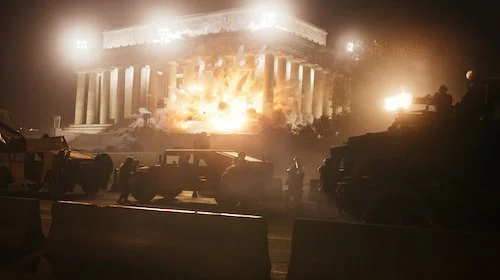Best Visual Effects: Ranking Every Nominee of the 97th Academy Awards
Written by Andreas Babiolakis
After tackling the Best Cinematography nominees yesterday (a stupidly competitive category, I might add), we move on to the other category which deals with what we see in films: Best Visual Effects. A once niche category which has become stronger as time has passed, I honestly feels like it gets trickier to rank and analyze the nominees within this group each year. While there are films with embarrassing effects that get churned out, there are projects that do take their time that boast tremendous visual effects: so much so that it can be difficult to tell what is real or crafted at times. I’ll be looking at which films are the most convincing with their CGI work. In that same breath, CGI isn’t always about being hyper real: sometimes, creativity and design are a part of the conversation. I’ll be regarding these aspects as well: which films had the most interesting concepts and executions. Finally, duration counts. A film can have amazing CGI for a short amount of time, versus another work that has CGI splendour throughout its entire runtime. I’ll use duration as a tie-breaker of sorts whenever needed. Let’s get into the thick of it.
Here are your nominees for Best Visual Effects ranked from worst to best.
Biggest Snub: Civil War
While I don’t think any of the five nominees are weak, I do want to use this opportunity to remind you all that, A), Alex Garland’s Civil War is a terrific film with amazing visual effects that should have been nominated here, and, B), that it’s a damn crying shame that Garland’s work continues to be forgotten by the Academy ever since Ex Machina did well around a decade ago. His works are usually magnificent and are criminally under-represented by the Academy, especially when it comes to the tech categories (Garland’s films are usually brilliantly made from the tech angle). Civil War is one of the best films of last year, and it should have been a shoe-in in at least this category, as well as Best Sound and Best Production Design.
5. Better Man-Luke Millar, David Clayton, Keith Herft and Peter Stubbs
No. I am not on the stupid, lazy, low-hanging-fruit train of idiots who blindly hate Better Man for pathetic reasons. Yes, I do know who Robbie Williams is, and has known who he is since I was a child. I am not ranking Better Man last as some sort of ego-stroking statement like many chronically online people are, because the joke was never funny. Not once. So, why did I place Better Man last? I do think the visual effects are great for the most part, especially since Williams as a chimpanzee does blend in nicely with the film (consider that the chimp is literally in the entire motion picture). The Knebworth performance is especially noteworthy not just because of the generated audience members and stage, but because of the surprising battle sequence that the film turns into (a moment that sealed the deal for Better Man being nominated here). All of this doesn’t answer the question. Why I have Better Man last is because the other nominees just look more convincingly real (especially that other film featuring apes), and there were a couple of moments — like with baby chimp Williams — where the CGI looked a little off, especially around the eyes and lip movements. I’m splitting hairs, but one has to when the nominees are all strong and I don’t want to rely on having ties in my rankings. Better Man still is quite a spectacle with its effects, all things considered.
4. Alien: Romulus-Eric Barba, Nelson Sepulveda-Fauser, Daniel MaCarin and Shane Mahan
The effects in Alien: Romulus are fantastic for the most part, outside of the unethical — and uncanny valley — use of deep fake technology to bring Ian Holm’s Ash android back from the dead (which is completely unnecessary, and it doesn’t look good to boot). Outside of that, Alien: Romulus is stacked with extremely strong effects, so much so that it was difficult to tell what was CGI and what was achieved via practical effects at times. Why is this film placed fourth then? The other three films rely on CGI for far longer periods of time, whereas Alien: Romulus also marvels with its makeup, prosthetics, and animatronic work (the film deserves its kudos in these departments for sure, and I’m a little surprised it wasn’t nominated for its makeup work, even in a tough year).
3. Wicked-Pablo Helman, Jonathan Fawkner, David Shirk and Paul Corbould
Wicked achieves a lot of its world building via lavish sets and intricate costumes — let’s not forget the green makeup either — but we can’t count out just how good the CGI in Wicked is. It’s there at every turn, either with a major focal point (see the goat professor above, who actually looks sensational, even in movement), or with little intricacies in the background to help this magical world pop. In fact, the CGI is so strong that you may forget that it is even there, which blends the film’s lines between practical and digital with ease. The other two nominees have mind-boggling CGI effects that cannot be ignored, but not only should Wicked also get its flowers in this department, I’m actually quite pleased that it got nominated: Wicked stands up to most superhero or action films that are CGI-heavy in recent memory. I said what I said.
2. Kingdom of the Planet of the Apes-Erik Winquist, Stephen Unterfranz, Paul Story and Rodney Burke
Kingdom of the Planet of the Apes is kind of the best of Wicked but on steroids (toss in Better Man’s chimp design with these even-stronger apes [and there’s countless apes] to boot). A vast majority of what we see in this latest iteration of the Apes franchise is digitally crafted, and that’s a lot to take in when the film is as long as it is and highly believable (the narrative, on the other hand, isn’t quite as strong as how this film looks and feels). Toss in the frequent action sequences, the gigantic settings (the ones that are fully CGI created, mind you), and the heaps of destruction, and you have an exposition of what great visual effects in a film look like. If it was any other year, this film may have had a chance of winning it all. However…
Cameron Geiser’s Review of Kingdom of the Planet of the Apes
1. Dune: Part Two-Paul Lambert, Stephen James, Rhys Salcombe and Gerd Nefzer
Of course, Dune: Part Two is going to come first. Just like the previous Dune, this sequel possesses some of the greatest visual effects of all time: so much so that, like other Denis Villeneuve projects (Arrival, Blade Runner 2049), there is already a high precedent set with what visual effects can achieve in cinema. The CGI is some of the most believable out there, the entire film is reliant on these effects working for the entire runtime, and the concepts are breathtaking by design. From the many modes of travel (mechanical vehicles and those massive sandworms) to the breathtaking action sequences (amongst countless other accomplishments), it feels impossible to rank any other film this year above Dune: Part Two. Once again, Dune and Dune: Part Two succeed at being complete cinematic spectacles, and a huge reason why is due to the game changing CGI work. It’s no contest, folks.
Who I Want To Win: Despite liking the visual effects in all of the nominated films, I’d be shocked and upset if anything but Dune: Part Two won.
Who I Think Will Win: As foretold by the Lisan al-Gaib, Dune: Part Two has this award in the bag. I don’t think any film will come close to winning it, either. Sorry for the lack of further insight, but, sometimes, Academy Award predictions are to-the-point and as obvious as they come.
The Academy Awards Project will continue tomorrow with another category: Best Production Design. We’re going to rank every single nominee in every single category, Monday through Friday. You don’t want to miss it!
Andreas Babiolakis has a Masters degree in Film and Photography Preservation and Collections Management from Ryerson University, as well as a Bachelors degree in Cinema Studies from York University. His favourite times of year are the Criterion Collection flash sales and the annual Toronto International Film Festival.









